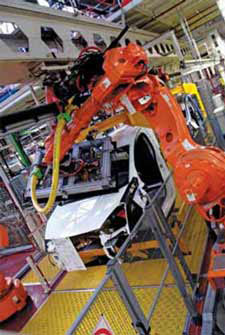Let me take you to a classroom of an elementary school in Daegu, southeast of Seoul: Students are working at their desks as the teacher reads books to them and calls out instructions. It’s a typical classroom scene except that the teacher, about 1-metre tall, is made of plastic and computer circuits.
Confused? Well, it’s an English language class taught by a robot teacher that rolls around the classroom on wheels, asking questions in English and dancing to music. The egg-shaped robot called ‘Engkey’ is linked to and controlled remotely by an English teacher outside the classroom (located as far away as Australia) whose face appears on the screen of the robot. Besides being popular with children, Engkey is a cost-effective way to help address South Korea’s shortage of qualified native-English speaking teachers.
Robotics, which has grown far beyond the realms of science fictions, has always been a fascinating subject. From simple robot toys to industrial robotics, robotics technology is today firmly entrenched into our day-to-day life and impacts our way of life much more than we think. The advancement in recent technologies continues to bring cyber and physical worlds together,enabling the robotics industry to grow even faster.
Let’s explore a career in robotics engineering.
Know the field
Let us first define the terms ‘robot’and ‘robotics.’ According to the RobotInstitute of America (1979), a robot is “A reprogrammable, multifunctionalmanipulator designed to move material,parts, tools or specialised devicesthrough various programmed motionsfor the performance of a variety oftasks.”
Webster defines a robot as “An automatic device that performs functions normally ascribed to humans or a machine in the form of a human.” More generally, it is a machine that functions in place of a living person.
Now coming to robotics, it’s a multidisciplinary area which integrates intelligent control,communications,computer vision, mechatronics, sensorfusion, design and many otheraspects on a single platform for a better service. This branch of technology is related to the sciences of electronics, engineering, mechanics and software.
“Robotics is a highly technical field of advanced engineering and technology. It involves practical skills backed by higher-end theory. It calls for innovative thinking, application and creativity— skills which are not found in textbooks,” explains Dr G. Venkatesh, adjunct professor, Global Academy of Technology, and managing director, Bangalore Robotics.
[stextbox id=”info”]
“Robotics involves practical skills backed by higher-end theory. It calls for innovative thinking, application and creativity.”
—skills which are not found in textbooks.
[/stextbox]
Saptarshi Chatterjee, head-strategic alliance and marcom, Robosoft Systems, defines robotics as an amalgamation of the latest engineering breakthroughs in embedded systems, ICT, mechanical product design, bioengineering, computer science and nanotechnology among others.
Industry optimistic about 2011
Robots are used in a diverse range of industries today, including automotive, aerospace, electronics and computers, industrial machinery, telecommunications, medicine, manufacturing, agriculture, mining and textiles. More than 120,000 industrial robots were shipped in 2010, with electronics, automotive and metal industries being the main sales drivers. The trend is likely to continue into 2011 and beyond with a further 10-15 per cent increase in robot sales.
The notion that the prospects for the robotics industry are looking up in 2011 is also shared by others in the supply chain, not just robot manufacturers.
According to the IFR (International Federation of Robotics) Quarterly Statistics on Industrial Robots, the robotics industry is capitalising on the increasing demand for automation, especially in the growing Asian markets with China on top. Though robot sales to India are still not much, it is a promising market with great demand for industrial robots in a wide range of industries.
Opportunities for students
According to Pulkit Gaur, chief technology officer and founder, Gridbots Technologies, “Robotics is going to be one of the biggest industrial catalysts and major factors for growth in production and material handling facilities. Engineering students can avail this opportunity by selecting this as one of the career options.”
With time, there is going to be an increase in the job availability in this sector. “Most of the production, manufacturing and material handling industries are looking for alternatives to increase the productivity, which will soon get reflected in the jobs sector with the adoption of robotic systems in these industries,” quips Gaur.
 Robotics can be applied to a variety of tasks that we need to perform within and outside our home. “Apart from special applications like handling hazardous situations and tasks that need high accuracy and speed, a new area of robotics called ‘service robotics’ has begun to develop. It targets medical, space, underwater and housekeeping applications,” shares Jayakrishnan T., director and country manager, Energid Robotics & Machines Vision.
Robotics can be applied to a variety of tasks that we need to perform within and outside our home. “Apart from special applications like handling hazardous situations and tasks that need high accuracy and speed, a new area of robotics called ‘service robotics’ has begun to develop. It targets medical, space, underwater and housekeeping applications,” shares Jayakrishnan T., director and country manager, Energid Robotics & Machines Vision.
“Obviously, these applications may demand smart vision, smooth fluid motion, interaction with the environment and artificial intelligence. This must create a very favourable situation for students (who are seeking a career in robotics) to apply their skills in order to support the developments in this connection,” he adds.










